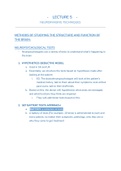- LECTURE 5 -
NEUROIMAGING TECHNIQUES
METHODS OF STUDYING THE STRUCTURE AND FUNCTION OF
THE BRAIN:
NEUROPSYCHOLOGICAL TESTS
- Neuropsychologists use a variety of tests to understand what's happening in
the brain
1. HYPOTHETICO-DEDUCTIVE MODEL
a. Used in SA and UK
a. Essentially, we structure the tests based on hypotheses made after
looking at the patient
i. EG: The doctor/neuropsychologist will look at the patient’s
medical history, talk to them about their symptoms, look at their
past scans, talk to their kin/friends.
b. Based on this, the doctor will hypothesise what areas are damaged,
and what functions they think are impaired
i. They will administer tests based on this
2. SET BATTERY TESTS APPROACH
a. BATTERY: a collection of tests
b. A battery of tests (For example, 10 tests) is administered to each and
every patient, no matter their symptoms, pathology, who they are or
why they came to get treatment
, TABLE OF THE PROS AND CONS OF NEUROPSYCHOLOGICAL TESTS
Neuropsychological Advantage Disadvantage
Test
Hypothetico-Deductive 1. The test will often be 1. Requires a lot of clinical
Model shorter (Instead of the expertise
patient waiting for 4-5 2. There is a too narrow focus
hours, they can be done in (sometimes something else
1 hour) that the patient struggles
with will be missed/go
unseen because they didn't
scan for everything)
Set Battery Approach 1. Scans for everything 1. Sometimes doctors miss
2. Sees all domains of why a patient is failing a
functioning (where a test
person might be struggling)
3. Requires less clinical
interpretation
4. Doesn't require as much
expertise
WHY HYPOTHETICO-DEDUCTIVE COULD BE FAVOURED:
- IMAGINE a patient is given a drawing and told to copy it on a separate piece
of paper, and they fail to do it
- There could be a multitude of reasons the patient cannot copy the
drawing (EG: frontal lobe damage, right hemisphere damage, impaired
attention etc…)
- The hypothetico-deductive approach would likely mean that doctors
would analyse this behaviour and run the appropriate tests that
correspond with the patient’s symptoms, like planning, audio and/or
visual processing tests
- The set battery approach would not allow for this
THE PROBLEM WITH HYPOTHETICO-DEDUCTIVE IN SA
- The neuropsychological tests that we use, are not made in SA, but instead in
the USA or UK
, - Therefore the tests are based on their culture, their language, the general
knowledge of people who live in the UK/USA and not our culture, language
or general knowledge
- This makes the tests CULTURALLY BIASSED
- Therefore when SA children, for example, take these western tests, they
might score ‘lower’ or ‘worse’ than western children
- This is because of the cultural bias, not the intelligence of SA children
FOR EXAMPLE: The Boston Naming Test
- A drawing of an object is given to a child and they are asked to name it
- A beaver is featured in the test, but most South African people have never
seen and may have never even heard of a beaver, because it’s not a native
animal
- Thus they are perceived as unintelligent, but in reality, they are just more
familiar to animals native to SA
TECHNIQUES IN NEUROPSYCHOLOGY
1. Take pictures of the brain while the person is still living (CTs and MRIs)
2. Study living tissues as it performs complex functions
a. Neuropsychologists can look at images and videos of the brain while
the individual performs a task
3. Lesioning and brain stimulation
LESIONING
- If there's damage to certain areas, we can predict that a certain
cognition/intellectual function is impaired




